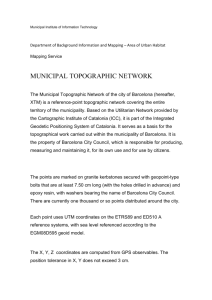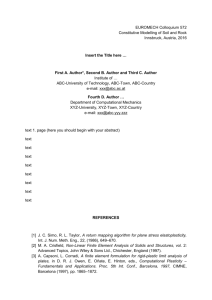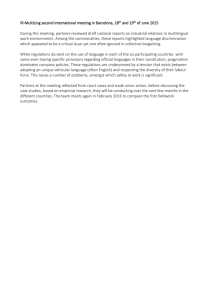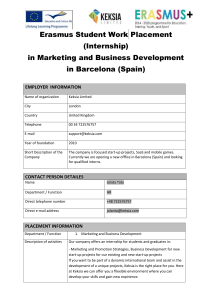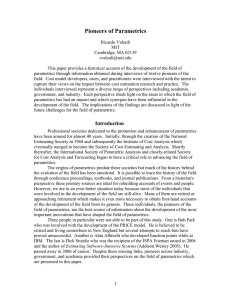Syllabus
advertisement
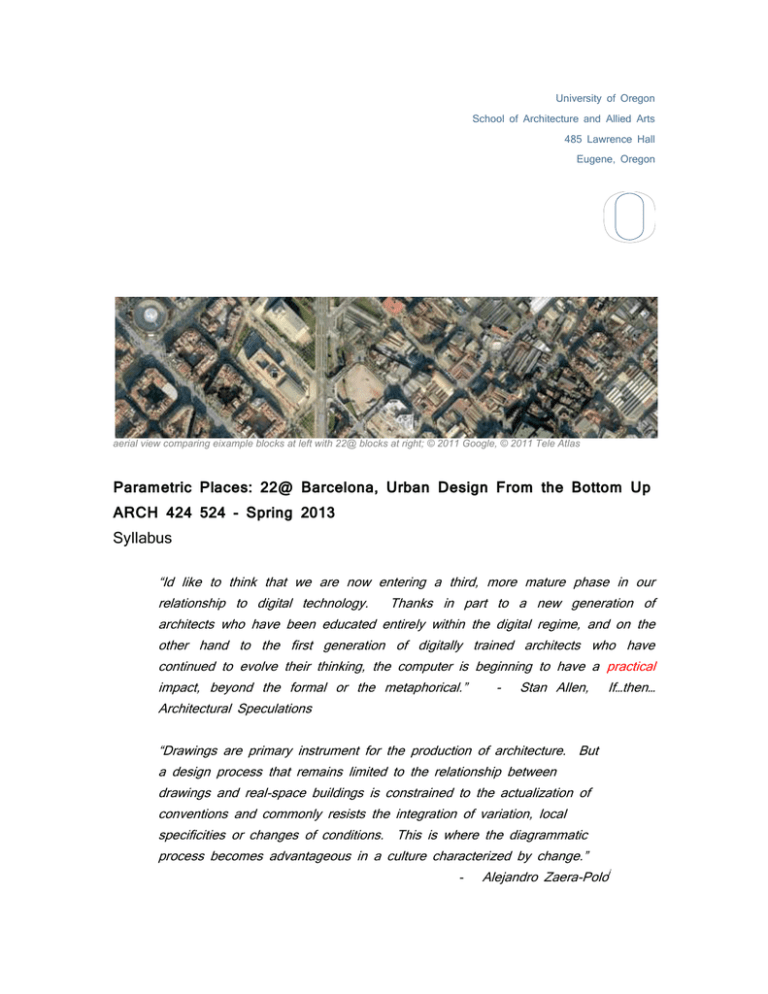
University of Oregon School of Architecture and Allied Arts 485 Lawrence Hall Eugene, Oregon aerial view comparing eixample blocks at left with 22@ blocks at right; © 2011 Google, © 2011 Tele Atlas Parametric Places: 22@ Barcelona, Urban Design From the Bottom Up ARCH 424 524 - Spring 2013 Syllabus “Id like to think that we are now entering a third, more mature phase in our relationship to digital technology. Thanks in part to a new generation of architects who have been educated entirely within the digital regime, and on the other hand to the first generation of digitally trained architects who have continued to evolve their thinking, the computer is beginning to have a practical impact, beyond the formal or the metaphorical.” Architectural Speculations - Stan Allen, If…then… “Drawings are primary instrument for the production of architecture. But a design process that remains limited to the relationship between drawings and real-space buildings is constrained to the actualization of conventions and commonly resists the integration of variation, local specificities or changes of conditions. This is where the diagrammatic process becomes advantageous in a culture characterized by change.” - Alejandro Zaera-Poloi INSTRUCTORS Philip Speranza, Assistant Professor speranza@uoregon.edu Office: 485 Lawrence TIME & PLACE Class meets on Tuesdays and Thursdays from 2:00- 3:50 PM, LA 278 COURSE OVERVIEW Working with and adding to Barcelona 22@ planning department guidelines, the research explored in this course will attempt to model as a system the block-by-block planning guidelines as a way to support city planning from the bottom up. The course will allow students to look closely at methods of adaptive systems design and how they allow the values of a place to emerge from the bottom up over time by various inhabitants including workers, residents and tourists. Work will be shared with the Ajuntament de Barcelona 22@ planning office as a way to support cultural sustainability. 22@ district planning The investigation will work at the scale of Barcelona Eixample blocks testing unit/whole cause and affect at the scale of the block, neighborhood and district. The current block planning guidelines transform the unplanned post-industrial blocks of 22a to provide for the 22@ objectives to for an information activities district for workers and residents. Block minimums require 10% of the following uses without specifying their locations: open space, residential and 7@ institutional use. The resulting abstract system adapts to existing conditions of protected art nouveau, Modernisme, built-fabric supporting an urbanism of agglomeration of smaller, fragmented lots and spaces for targeted small and medium sized information and design enterprises. The strategy prescribes no further top-down relationships between symmetrical blocks yet gaming theory suggests that minimal inequities will cause asymmetrical ‘tilting.’ How will existing and predicted real-life differences affect this abstract system including existing builtfabric, social behaviors, transportation networks, edge conditions, uses, and geographic orientation? How can this planning strategy provide a framework for participation that is evolvable? Case studies will include urban system design by Ana Pla Catala, Michael Weinstock, Patrick Schumacker and Zaha Hadid, Stan Allen and James Corner, Vicente Guallart, MVRDV and others. The case studies will give students an opportunity to develop techniques of parametric design at the scale of the city, testing limits, theory and context behind each designer’s work. The second part of the course will allow students to develop an abstract bottom-up parametric system that is calibrated and applied to the real-world contextual conditions of the 22@ district and other locations including Portland and Eugene. Student knowledge of abstract diagramming techniques, Rhinoceros and Grasshopper will he helpful. The course will utilize theoretical readings, techniques and bottom-up urban design methods in a lecture and workshop format. 22@ use guidelines, Ajuntament de Barcelona COURSE PURPOSE / INTRODUCTION - Learn the limits of parametrics and urban design - Neighborhood planning and identity, bottom up, in 22@ - Build parametric skills - Theory, reading and writing skills, update of contemporary conversation - Plug Department of Architecture into global conversation of parametrics and urban design topic (weblog that feeds to DMC and Department website) APPROACH, READINGS - 22@ Background + Theory on Adaptive Systems o Bruno Latour & Albena Yaneva, Give me a Gun and Ill Make All Buildings Move o Philip Speranza, Parametric Places 22@: Smart Urban Analysis Tools and Place Branding Value o Stan Allen, Field Conditions (Systems thinking) o James Corner, Not Unlike Life Itself (Frameworks: openended but specific) o Alejandro Zaera-Polo, Between Ideas and Matter (Abstract and real; Drawings and Diagrams) o Philip Speranza, Place Branding from the Bottom Up: Strengthening Cultural Identity through Small-Scaled Connectivity o Jane Jacobs, The Nature of Economies (Positive and negative feedbacks) o Manuel De Landa, A Thousand Years of Non-Linear History, (evolvable criteria + agglomeration) o 22@ Ten Years of Urban Renovation: models, MBM, Manel Bailo, others o PUARL Paper: Eixample, Olympic Village, 22@ o Manuel Sola-Morales: 10 lessons of Barcelona, chapter “05: The Eixample” DATA / METHOD I. Case Studies of Parametrics and urbanism: rebuilding Grasshopper definitions - Michael Weinstock, AA - Anna Pla Catala, Harvard GSD and IE - Patrick Shumaker and Zaha Hadid - Field Operations, Allen Corner - MVDRV - Vicente Guallart, IaaC - Karen McClosky, University of Pennsylvania - Neil Leach and others II. Creating systems- kickoff project - Abstract o Analog tiling, Time Based systems, modeling bottom-up systems o Simple parametrics, Grasshopper intro o Map existing conditions o Identify live inputs? How to integrate live inputs? o Inputs to system? 22@ data, Oregon data SRML, cell phones, GIS? - Real World, 22@ study area o Select study area + District, neighborhood, urban room o **Limits of study- not qualitative, how to indicate qualitative aspects o What are parameters? What is timeline, period of time based system? o Software limits? Artist Janet Echelman; Architect Philip Speranza; ARUP Engineering; diamond drawing Buro Happold, stress image by ARUP London, Photo © Will Novak Deliverables: Reading, Writing abstracts/outlines, discussions - Weeks 1-2 intensely building a dialogue/language o (Write once a week, Final 2 weeks no writing) Case Study diagrams - Week 2, carry hand drawn diagrams throughout term (Vicente Guallart diagrams) Rebuild Case Study or kickoff system in Grasshopper - Weeks 2-3, unit to whole - Week 4, presentations to group (share, identify, understand why, chart findings) Final project in Grasshopper - Weeks 5-9 o Research, week 5 o Analog building system, week 5-6 o Testing technique, abstract, 6-7 **Present findings to group, limits, questions o Building system, 22@ unit/whole, 7-9 o Final system, second pass, design communication, 9-10 FINDINGS Paper with 5 images or other graphic deliverable to Ajuntament de Barcelona 22@. Final event presentation show, movie/animation, fabrications of abstract system + scenarios CRITICAL DESIGN ISSUES - Context Organizational systems Parametric Modeling at the scale of blocks and the city METHOD This course is organized as one lecture group and smaller lab setting in which students engage in independent project-based learning. The course time will be split between lectures, discussion and workshops using the analog and digital media in the lab environment. The work will be shared in class to foster peerto-peer learning. Class meetings include a variety of communication formats including lectures, tutorials, desk-critiques, pin-ups, reviews, in-class discussions and reading assignments. digital archiving system. *Students are required to document their work to a EVALUATION Performance in course will be graded. Student work will be evaluated for achievement in all of the areas listed in the Department of Architecture's studio evaluation form. ATTENDANCE POLICY Students are expected to attend all course meetings, be on time, and stay for the entire scheduled session working on course activities. Unexcused absences are not permitted. Students with three (3) or more unexcused absences are required to meet with their instructor before returning to studio. Excused absences (such as illness or personal emergency) must be reported to the instructor prior to the missed class if at all possible. Grading 20% PROJECT 1 /// Writing Assignment 30% PROJECT 2 /// Case Study 40% PROJECT 3 /// Final definition and application/test 10% Class Participation Students will not receive a final grade until all work has been uploaded for digital submission. Projects The projects for this course are designed to encourage exposure to various means of communicating your designs through a variety of tools including everything from hand sketching to digital modeling. Detailed descriptions and requirements will be given at the time each project is assigned. Schedule (this schedule may change with notice) Background, Objective, Language: 22@, Barcelona, Grasshopper, Parametrics; Writing Assignment Week 1 Lecture/Workshop Lecture/Workshop Case Studies T Th Week 2 Lecture/Workshop Week 3 Lecture/Workshop Th Workshop 04/16 Definitions development 04/18 T Th 04/09 AnalogDigital Parametrics 04/11 T Week 4 Lecture/Workshop 04/04 Barcelona+Parametrics T Th 04/02 Introductory Lecture Workshop 04/23 Presentations 04/25 Workshop Final Project, definition modeling 22@ block guidelines Week 5 Lecture/Workshop T 04/30 Th Week 6 Lecture/Workshop T Th Week 7 Lecture/Workshop Th Presentations Week 9 Lecture/Workshop confirmed 05/07 Workshop 05/14 05/16 T Th Workshop 05/09 T Week 8 Lecture/Workshop 05/02 Workshop 05/21 05/23 T Review/ 05/28 Th 05/30 Workshop Week 10 F 06/07 Final presentation, date to be confirmed Week 11 F 06/07 Digital Archive Posting, date to be Attendance Attendance is mandatory. Lateness will be counted 15 minutes after class has started. Absences will be counted 30 minutes after class has started. After 3 unexcused absences your grade will be lowered by a grade point for each additional absence if you do not have a written medical, school or religious excuse. All students are expected to participate in class discussions and to develop their projects beyond the minimum requirement. PROJECT OWNERSHIP, PUBLICATION, AND PUBLICITY Work created for credit and/or using the facilities of the School of Architecture and Allied Arts belongs jointly to the school and the student. The AAA reserves the right to document and display all original work for the purpose of documenting student performance as mandated by the National Architecture Accrediting Board [NAAB]. Furthermore, the school reserves the non-exclusive right to use images or likenesses of the work for publicity and display in print and electronic media as well as to submit such work for competitively reviewed exhibitions or to various award programs, The School and its representatives [including faculty and teaching staff] have the non-exclusive right to use such work as illustrations in scholarly and/or technical publications and presentations. DISABLED STUDENTS If you have a documented disability and anticipate needing accommodations in this course, please make arrangements to meet with faculty soon. You should also request that the counselor for students with disabilities send a letter verifying your disability. Reading References Allen, S. (1999), “Field Conditions,” Points and Lines, Princeton Architectural Press, New York, NY. Allen, S. (1998), “Diagrams Matter”, in ANY 23, Dec. 1998 Barcelo, M. (2001), La Ciutat Digital, Pacte Industrial de la Regio Metropolitana de Barcelona, Beta Editorial Franck, K (2007) Design from the Inside Out, Wiley, West Sussex, England Jacobs, J. (2001), The Nature of Economies, Random House, New York, NY. Jacobs, J. (1969), The Economies of Cities, Vintage Books, New York, NY. Koolhaas, R. (1994), Delirious, Monacelli, New York, NY. de Landa, M. (2000), A Thousand Years of Nonlinear History, Zone Books, MIT Press, Cambridge, MA. de Landa, M. (2001), course lecture for: Theories of Self Organization the Dynamics of Cities. GSAPP, Columbia University Scwartz, P. (1991), The Art of the Long View, Doubleday, New York, NY Tschumi, B. (1996), Architecture and Disjunction, MIT Press, Cambridge, MA. Zaera-Polo, Alejandro (2010) “Between Ideas and Matters: Icons, Indexes, Diagrams, Drawings and Graphs”, AD The Diagrams of Architecture, Wiley, West Sussex, England
